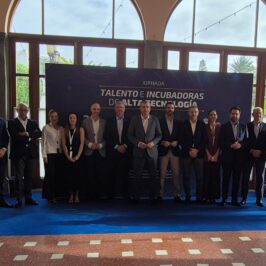
The native flora of the Strait of Gibraltar begins to adapt to the presence of the invasive algae Rugulopteryx okamurae in the Bay of Algeciras. It is one of the conclusions of the extensive study on this species carried out by the University of Seville with the sponsorship of the Cepsa Foundation that have been presented this Friday by the scientist José Carlos García at the Higher Technical School of Engineering of Algeciras.
The professor of The line Jose Carlos Garcia has influenced the appreciation of how the local ecosystem is beginning to regulate, creating microorganisms that already live on the algae itself, placing themselves on top of it.
The professor began his presentation by referring to the fact that the conclusions of the study, which lasted five years, are “difficult to digest” because there is no precedent for any algae invasion in the world at this level, with a reproductive process that makes it intractable, “so the only hope is that the local ecosystem put it in its place as has happened with other invasive species in other parts of the world”.
García has assured that the ecological damage - since 2015, when it was detected for the first time - has been “stratospheric“. It is a first-rate competitive species with a great capacity to adapt to an area that is not its own and that is also loaded with chemicals that make it practically incomestible for wildlife.
The research, which has been carried out in practically the entire Bay of Algeciras, studying both the surface and underwater, has opened other lines of work in a more positive area to take advantage of these algae. It is about the realization of fertilizers of quality in which the Sevilla University in collaboration with the University of Extremadura; the creation of biomethane and products pharmacological and of parapharmacy, where the Faculty of Pharmacy of the University of Seville has begun to work.
García added that the arrival Going out to the beach is the main problem that people have to face. town halls, cleaning the beaches, often taking the sand with shovels, but he pointed out that the real impact is under the water where it is seen that “he has taken everything ahead”.
The study reports on the different sources of entry of the Asian algae into the Narrow. The scientist insists that the plastics have had a lot to do with its expansion. The invasive species is placed on this floating material and sinks, helping to disperse. He assures that the ballast water has been one of the inputs but not the most important, the transport of goods and the lack of control of the aquaculture -breeding of aquatic plant and animal species- have had a lot to do with it, according to García. “In the Eastern Mediterranean, the entry of the algae that is already being seen in Marseilles and other points has been due to aquaculture”, points out García.
The biofuling, incrustations of microorganisms on the hulls of ships, is another important entry route through recreational boats that remain docked in ports for years.
Regarding the dispersion of the Rugulopteryx okamurae, The research concludes that it also adapts to the shady area and is located in the rocks. “With the cameras installed we have seen how they surround the local algae and take its place.”says García. “The ecosystem has changed but there are some positive aspects. The fish are eating the crustaceans that already live on the algae”, concludes the scientist.
Sources: EuropaSouth









